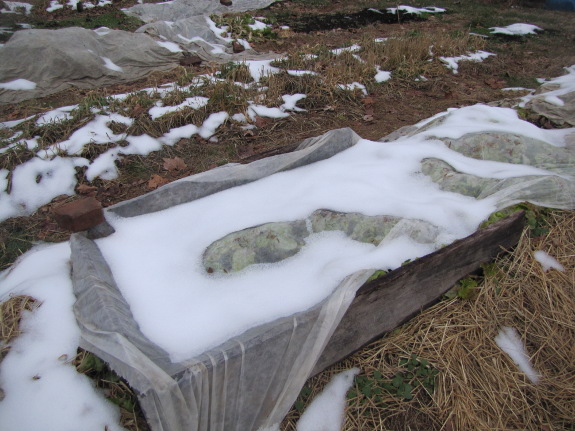
Garden hardiness after hard winter freeze

I was very curious to
see how the garden had dealt with abnormally low temperatures while we
were gone. Row covers actually didn't seem to have made much
difference, probably because we had a heavy snow cover before the cold
spell that helped insulate the plants. Broccoli pretty much
kicked the bucket whether it was under the row cover or not while
greens were happily growing in both places.
By Tuesday afternoon,
the snow had melted enough that I could roll back the row cover fabric
and check on the lettuce as well. These salad greens seemed to be
midway between broccoli and cooking greens in their tolerance to the
cold, with lots of frost-damaged leaves where the lettuce had touched
the cold fabric but also enough fresh leaves that I could pick and
choose a nice salad for supper. (I added in some young kale for
variety and topped it off with a winter version of our sweet
corn, bean, and tomato salad.)

We grew two different
varieties of lettuce this fall --- Bibb on the left and Black-seeded
Simpson on the right. Black-seeded Simpson is usually my favorite
since it stays sweet for a long time and is well adapted to our local
climate, but the mayor of our closest town, who also runs the local
hardware store, gave us some Bibb seeds to try out and I decided to
give them a shot. I won't be trying Bibb again. As you can
see in the paired photos, Bibb seemed much less tolerant of freezing
snow cover than Black-seeded Simpson, and I also find the leaves a bit
coarser and not as sweet.
Of course, for next year
I know that I should try some of the even more cold-hardy
winter greens like
spinach and mache. And I can definitely see the merits of quick
hoops now --- I
suspect the lettuce leaves wouldn't have been nipped at all if the
heavy snow hadn't pushed the fabric down on top of them. For this
winter, though, I just count us very luck to be eating sweet, fresh
leaves on the Winter Solstice.
Want more in-depth information? Browse through our books.
Or explore more posts by date or by subject.
About us: Anna Hess and Mark Hamilton spent over a decade living self-sufficiently in the mountains of Virginia before moving north to start over from scratch in the foothills of Ohio. They've experimented with permaculture, no-till gardening, trailersteading, home-based microbusinesses and much more, writing about their adventures in both blogs and books.
Want to be notified when new comments are posted on this page? Click on the RSS button after you add a comment to subscribe to the comment feed, or simply check the box beside "email replies to me" while writing your comment.
